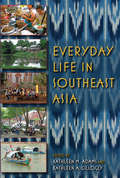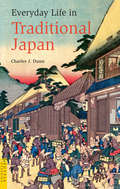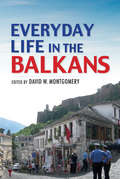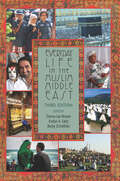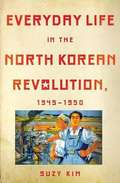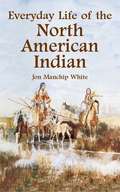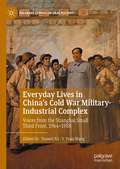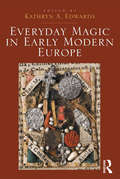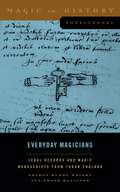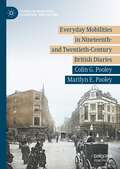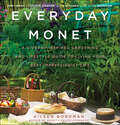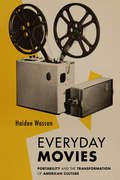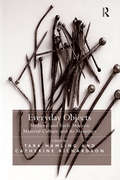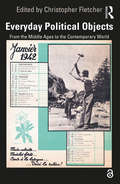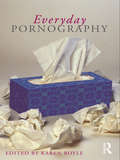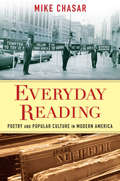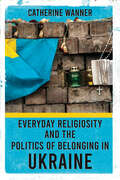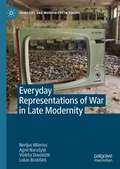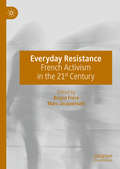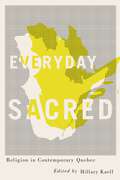- Table View
- List View
Everyday Life in Southeast Asia
by Kathleen A. Gillogly Kathleen M. AdamsThis lively survey of the peoples, cultures, and societies of Southeast Asia introduces a region of tremendous geographic, linguistic, historical, and religious diversity. Encompassing both mainland and island countries, these engaging essays describe personhood and identity, family and household organization, nation-states, religion, popular culture and the arts, the legacies of war and recovery, globalization, and the environment. Throughout, the focus is on the daily lives and experiences of ordinary people. Most of the essays are original to this volume, while a few are widely taught classics. All were chosen for their timeliness and interest, and are ideally suited for the classroom.
Everyday Life in Traditional Japan
by Laurence Broderick Charles J. DunnEveryday Life in Traditional Japan paints a vivid portrait of Tokugawa Japan, a time when contact with the outside world was deliberately avoided and the daily life of the different classes consolidated the traditions that shaped modern Japan.With detailed descriptions and over 100 illustrations, authentic samurai, farmers, craftsmen, merchants, courtiers, priests, entertainers and outcasts come to life in this magnificently illustrated portrait of a colorful society. Most works of Japanese history fail to provide enough details about the lives of the people who lived during the time. The level of detail in Everyday Life in Traditional Japan allows for a more complete picture of the history of Japan.In fascinating detail, Charles J. Dunn, describes how each class lived: their food, clothing, and houses; their their beliefs and their fears. At the same time he takes account of certain important groups that fell outside the formal class structure, such as the courtiers in the emperor's palace at Kyoto, the Shinto and Buddhist priests, and the other extreme, the actors and the outcasts. he concludes with a lively account of everyday life in the capital city of Edo, the present-day Tokyo.
Everyday Life in the Balkans
by David W. MontgomeryEveryday Life in the Balkans gathers the work of leading scholars across disciplines to provide a broad overview of the countries of Albania, Bosnia and Herzegovina, Bulgaria, Croatia, Greece, Kosovo, Macedonia, Romania, Serbia, and Turkey. This region has long been characterized as a place of instability and political turmoil, from World War I, through the Yugoslav Wars, and even today as debate continues over issues such as the influx of refugees or the expansion of the European Union. However, the work gathered here moves beyond the images of war and post-socialist stagnation which dominate Western media coverage of the region to instead focus on the lived experiences of the people in these countries. Contributors consider a wide range of issues including family dynamics, gay rights, war memory, religion, cinema, fashion, and politics. Using clear language and engaging examples, Everyday Life in the Balkans provides the background context necessary for an enlightened conversation about the policies, economics, and culture of the region.
Everyday Life in the Muslim Middle East, Third Edition
by Lila Abu-Lughod Dawn Chatty Marcia C. Inhorn Farha Ghannam Jonathan Holt Shannon Sherine Hamdy Jenny White Susan Slyomovics Melani Cammett Ziba Mir-Hosseini Fida J. Adely Kristin V. Monroe Brian Silverstein Walter Armbrust Samer S. Shehata Andrew Gardner Diane Singerman William O. Beeman Quintan Wiktorowicz Robert R. Bianchi Victoria Fontan Christine El Ouardani Momina Zakzouk Anne H. Betteridge Steven Caton Angel Foster Simon Hawkins Natalie K. Jensen Kristina Nelson Yagmur Nuhrat Marcie Patton Erika Friedl Loeffler Brian K. BarberThe substantially revised and updated third edition of Everyday Life in the Muslim Middle East focuses on the experiences of ordinary men, women, and children from the region. Readers will gain a grassroots appreciation of Middle East life, culture, and society that recognizes the impact of wars and uprisings as well as changes to Islamic practice due to advances in technology. The book also explores the influence of social media on politics and labor relations and the changing status of women, family values, marriage, childrearing, gender, and gay rights. This dynamic and imaginative volume continues to provide a rich resource for understanding contemporary Muslim culture in the Middle East.
Everyday Life in the North Korean Revolution, 1945–1950
by Suzy KimDuring the founding of North Korea, competing visions of an ideal modern state proliferated. Independence and democracy were touted by all, but plans for the future of North Korea differed in their ideas about how everyday life should be organized. Daily life came under scrutiny as the primary arena for social change in public and private life. In Everyday Life in the North Korean Revolution, 1945-1950, Kim examines the revolutionary events that shaped people's lives in the development of the Democratic People's Republic of Korea. By shifting the historical focus from the state and the Great Leader to how villagers experienced social revolution, Kim offers new insights into why North Korea insists on setting its own course.Kim's innovative use of documents seized by U.S. military forces during the Korean War and now stored in the National Archives--personnel files, autobiographies, minutes of organizational meetings, educational materials, women's magazines, and court documents--together with oral histories allows her to present the first social history of North Korea during its formative years. In an account that makes clear the leading role of women in these efforts, Kim examines how villagers experienced, understood, and later remembered such events as the first land reform and modern elections in Korea's history, as well as practices in literacy schools, communal halls, mass organizations, and study sessions that transformed daily routine.
Everyday Life in the Philippines, 1657–1699: Selections from the Manuscripts of Juan de Paz
by Norah L. A. Gharala Marya Svetlana T. Camacho Juan O. MesquidaThis book examines the legacy of one of the most influential members of Spanish society in the seventeenth-century Philippines, Dominican scholar Juan de Paz. Using a unique manuscript from the collections of the Archivo de la Universidad de Santo Tomás in Manila, the authors provide a window into the concerns, problems, and entanglements of people of different ethnicities, occupations, and stations in life. Paz’s writings resolving conflicts and weighing in on questions (consultas) have not previously been translated into English. The transcriptions, translations, and editorial introductions collected in this volume therefore make it an invaluable resource for students and scholars interested in the cultural and social history of the Philippines and the Spanish empire.
Everyday Life of the Aztecs, Incas, and Maya
by Neil MorrisThis exciting new series peels back the years to uncover a wealth of information about ancient civilizations from around the world. Touching upon fashion, warfare, architecture, government, and much more, "Uncovering History breathes life into the past. Transparent overlays add to the fun, letting readers make their own discoveries.
Everyday Life of the North American Indian (Native American)
by Jon Manchip WhiteThis book by the author of several outstanding studies of ancient peoples vividly recounts the story of the Native Americans -- from their earliest beginnings as immigrants from the Asian mainland, to their lives as tragic figures on U. S. government-authorized reservations.A story of great depth and perspective, Everyday Life of the North American Indian traces the subjects' various roles in the New World: as nomad, hunter, and farmer; as athlete, warrior, parent, and spouse; as witch doctor, worshipper, artist, and craftsman.Enhanced with more than 100 illustrations, this comprehensive, highly readable book will be valued by students of American history and welcomed by all those intrigued by Native American culture.
Everyday Lives in China's Cold War Military-Industrial Complex: Voices from the Shanghai Small Third Front, 1964-1988 (Palgrave Studies in Oral History)
by Y. Yvon Wang Youwei XuThis book translates and contextualizes the recollections of men and women who built, lived, and worked in some of the factory compounds relocated from China’s most cosmopolitan city—Shanghai. Small Third Line factories became oases of relatively prosperous urban life among more impoverished agricultural communities. These accounts, plus the guiding questions, contextual notes, and further readings accompanying them, show how everyday lives fit into the sweeping geopolitical changes in China and the world during the Cold War era. Furthermore, they reveal how the Chinese Communist Party’s military-industrial strategies have shaped China’s economy and society in the post-Mao era. The approachable translations and insight into areas of life rarely covered by political or diplomatic histories like sexuality and popular culture make this book highly accessible for classroom use and the general-interest reader.
Everyday Magic in Early Modern Europe
by Kathryn A. EdwardsWhile pre-modern Europe is often seen as having an 'enchanted' or 'magical' worldview, the full implications of such labels remain inconsistently explored. Witchcraft, demonology, and debates over pious practices have provided the main avenues for treating those themes, but integrating them with other activities and ideas seen as forming an enchanted Europe has proven to be a much more difficult task. This collection offers one method of demystifying this world of everyday magic. Integrating case studies and more theoretical responses to the magical and preternatural, the authors here demonstrate that what we think of as extraordinary was often accepted as legitimate, if unusual, occurrences or practices. In their treatment of and attitudes towards spirit-assisted treasure-hunting, magical recipes, trials for sanctity, and visits by guardian angels, early modern Europeans showed more acceptance of and comfort with the extraordinary than modern scholars frequently acknowledge. Even witchcraft could be more pervasive and less threatening than many modern interpretations suggest. Magic was both mundane and mysterious in early modern Europe, and the witches who practiced it could in many ways be quite ordinary members of their communities. The vivid cases described in this volume should make the reader question how to distinguish the ordinary and extraordinary and the extent to which those terms need to be redefined for an early modern context. They should also make more immediate a world in which magic was an everyday occurrence.
Everyday Magicians: Legal Records and Magic Manuscripts from Tudor England (Magic in History Sourcebooks)
by Frank Klaassen Sharon Hubbs WrightMost of the women and men who practiced magic in Tudor England were not hanged or burned as witches, despite being active members of their communities. These everyday magicians responded to common human problems such as the vagaries of money, love, property, and influence, and they were essential to the smooth functioning of English society. This illuminating book tells their stories through the legal texts in which they are named and the magic books that record their practices.In legal terms, their magic fell into the category of sin or petty crime, the sort that appeared in the lower courts and most often in church courts. Despite their relatively lowly status, scripts for the sorts of magic they practiced were recorded in contemporary manuscripts. Juxtaposing and contextualizing the legal and magic manuscript records creates an unusually rich field to explore the social aspects of magic practice. Expertly constructed for both classroom use and independent study, this book presents in modern English the legal documents and magic texts relevant to ordinary forms of magic practiced in Tudor England. These are accompanied by scholarly introductions with original perspectives on the subjects. Topics covered include: the London cunning man Robert Allen; magic to identify thieves; love magic; magic for hunting, fishing and gambling, and magic for healing and protection.
Everyday Mobilities in Nineteenth- and Twentieth-Century British Diaries (Studies in Mobilities, Literature, and Culture)
by Colin G. Pooley Marilyn E. PooleyThis book uses diaries written by ordinary British people over the past two centuries to examine and explain the nature and extent of everyday mobilities, such as travel to school, to work, to shop or to visit friends, and to explore the meanings attached to these mobilities. After a critical evaluation of diary writing, the ways in which mobility changed over time, interacted with new forms of transport technology, and varied from place to place are examined. Further chapters focus on the roles of family and life course, gender, income and class, and journey purpose in shaping mobilities, including immobility. It is argued that easy and frequent everyday mobilities were experienced by most of the diarists studied, that travellers could exercise their own agency to adapt easily to new forms of transport technology, but that factors such as gender, class, and location also created significant mobility inequalities.
Everyday Monet: A Giverny-Inspired Gardening and Lifestyle Guide to Living Your Best Impressionist Life ("rebel Inc. " Classics Ser. #17)
by Aileen BordmanBring Monet’s paintings and gardens to life using this gorgeously illustrated book that will teach you how to create a Monet lifestyle from your living room to your kitchen to your garden—from the documentarian and author of Monet’s Palate Cookbook, with the support of the American steward and all the head gardeners at Giverny.Aileen Bordman has long been influenced by the work of Claude Monet, one of the founders of French Impressionist painting whose esteemed works capturing the simple beauties of fin de siècle French life—from waterlilies to haystacks—have fetched astonishing sums at private auction houses and can be found in the greatest art museums around the globe. With direct access to Giverny through a pair of insiders—her mother, a steward of the Giverny estate, and its head gardener—she transports you to Monet’s garden at Giverny, the third most visited site in France, in Everyday Monet.Combining the history, palette colors, and designs of Monet’s gardens and paintings in this one-of-a-kind volume, Aileen shows how to encapsulate a home and lifestyle inspired by the artist. Filled with insights, step-by-step instructions, musings, recipes, gorgeous photography, and how-to graphics, Everyday Monet teaches how to grow a garden like Monet, preserve a waterlily inside the home, decorate a dining room table or a bathroom inspired by Monet’s aesthetic, and prepare foods that inspire your inner-Impressionist.Filled with lush photos of Monet’s milieu—from the gardens of Giverny to the streets of Normandy—and reproductions of Monet’s most famous paintings, Everyday Monet is a practical guide to finding ways to implement Monet’s beautiful designs into any home and garden, whether you live on a country estate or in a city apartment, and is a memorable keepsake Monet devotees will treasure.
Everyday Movies: Portable Film Projectors and the Transformation of American Culture
by Haidee WassonEveryday Movies documents the twentieth-century rise of portable film projectors. It demonstrates that since World War II, the vast majority of movie-watching did not happen in the glow of the large screen but rather took place alongside the glitches, distortions, and clickety-clack of small machines that transformed home, classroom, museum, community, government, industrial, and military venues into sites of moving-image display. Reorienting the history of cinema away from the magic of the movie theater, Haidee Wasson illustrates the remarkable persistence and proliferation of devices that fundamentally rejected the sleek, highly professionalized film show. She foregrounds instead another kind of apparatus, one that was accessible, affordable, adaptable, easy to use, and crucially, programmable. Revealing rich archival discoveries, this book charts a compelling and original history of film that brings to light new technologies and diverse forms of media engagement that continue to shape contemporary life.
Everyday Objects: Medieval and Early Modern Material Culture and its Meanings
by Catherine Richardson Tara HamlingThis book is about the objects people owned and how they used them. Twenty-three specially written essays investigate the type of things that might have been considered 'everyday objects' in the medieval and early modern periods, and how they help us to understand the daily lives of those individuals for whom few other types of evidence survive - for instance people of lower status and women of all status groups. Everyday Objects presents new research by specialists from a range of disciplines to assess what the study of material culture can contribute to our understanding of medieval and early modern societies. Extending and developing key debates in the study of the everyday, the chapters provide analysis of such things as ceramics, illustrated manuscripts, pins, handbells, carved chimneypieces, clothing, drinking vessels, bagpipes, paintings, shoes, religious icons and the built fabric of domestic houses and guild halls. These things are examined in relation to central themes of pre-modern history; for instance gender, identity, space, morality, skill, value, ritual, use, belief, public and private behaviour, continental influence, materiality, emotion, technical innovation, status, competition and social mobility. This book offers both a collection of new research by a diverse range of specialists and a source book of current methodological approaches for the study of pre-modern material culture. The multi-disciplinary analysis of these 'everyday objects' by archaeologists, art historians, literary scholars, historians, conservators and museum practitioners provides a snapshot of current methodological approaches within the humanities. Although analysis of material culture has become an increasingly important aspect of the study of the past, previous research in this area has often remained confined to subject-specific boundaries. This book will therefore be an invaluable resource for researchers and students interested in learning about important new work which demonstrates the potential of material culture study to cut across traditional historiographies and disciplinary boundaries and access the lived experience of individuals in the past.
Everyday People in Early Modern Kyoto: Family, Firm and Community
by Mary Louise NagataThis social history explores the lives of urban commoners in early modern Kyoto during the dramatic political shift from famine to revolution in the final decades of the Tokugawa regime, through an extensive survey of the detailed record changes from 1843 in response to these crises.The study focuses on three aspects of urban life, beginning with individual and household relations with the neighborhood communities that comprised the institutional framework of urban administration and provided financial and legal resources for residents. It then moves to the lives of ordinary people, taking a life-course approach to analyze life-cycle work: marriage, divorce, blended families, fertility, adoption, migration, mobility, and mortality. The final theme discusses households people lived in, headship succession and devolution of property; family business as a network of household shops and workshops; and the roles women played, while testing the patriarchy theories commonly used in this field and finding new explanations.Written for all levels of expertise and including many stories of everyday people, this book will appeal to undergraduate students and general readers interested in historical Kyoto.
Everyday Political Objects: From the Middle Ages to the Contemporary World
by Christopher FletcherEveryday Political Objects examines a series of historical case studies across a very broad timescale, using objects as a means to develop different approaches to understanding politics where both internal and external definitions of the political prove inadequate. Materiality and objects have gradually made their way into the historian’s toolbox in recent years, but the distinctive contribution that a set of methods developed for the study of objects can make to our understanding of politics has yet to be explored. This book shows how everyday objects play a certain role in politics,which is specific to material things. It provides case studies which re-orientate the view of the political in a way that is distinct from, but complementary to, the study of political institutions, the social history of politics and the analysis of discourse. Each chapter shows, in a distinctive and innovative way, how historians might change their approach to politics by incorporating objects into their methodology. Analysing case studies from France, the Congo, Burkina Faso, Romania and Britain between the early Middle Ages and the present day makes this study the perfect tool for students and scholars in the disciplines of history, art history, political science, anthropology and archaeology.
Everyday Pornography
by Karen BoylePublic and academic debate about ‘porn culture’ is proliferating. Ironically, what is often lost in these debates is a sense of what is specific about pornography. By focusing on pornography’s mainstream – contemporary commercial products for a heterosexual male audience – Everyday Pornography offers the opportunity to reconsider what it is that makes pornography a specific form of industrial practice and genre of representation. Everyday Pornography presents original work from scholars from a range of academic disciplines (Media Studies, Law, Sociology, Psychology, Women’s Studies, Political Science), introducing new methodologies and approaches whilst reflecting on the ongoing value of older approaches. Among the topics explored are: the porn industry’s marketing practices (spam emails, reviews) and online organisation commercial sex in Second Life the pornographic narratives of phone sex and amateur videos the content of best-selling porn videos how the male consumer is addressed by pornography, represented within the mainstream, understood by academics and contained by legislation. This collection places a particular emphasis on anti-pornography feminism, a movement which has been experiencing a revival since the mid-2000s. Drawing on the experiences of activists alongside academics, Everyday Pornography offers an opportunity to explore the intellectual and political challenges of anti-pornography feminism and consider its relevance for contemporary academic debate.
Everyday Reading: Poetry and Popular Culture in Modern America
by Mike ChasarExploring poetry scrapbooks, old-time radio show recordings, advertising verse, corporate archives, and Hallmark greeting cards, among other unconventional sources, Mike Chasar casts American poetry as an everyday phenomenon consumed and created by a vast range of readers. He shows how American poetry in the first half of the twentieth century and its reception helped set the stage for the dynamics of popular culture and mass media today. Poetry was then part and parcel of American popular culture, spreading rapidly as the consumer economy expanded and companies exploited its profit-making potential. Poetry also offered ordinary Americans creative, emotional, political, and intellectual modes of expression, whether through scrapbooking, participation in radio programs, or poetry contests. Reenvisioning the uses of twentieth-century poetry, Chasar provides a richer understanding of the innovations of modernist and avant-garde poets and the American reading public's sophisticated powers of feeling and perception.
Everyday Religiosity and the Politics of Belonging in Ukraine
by Catherine WannerEveryday Religiosity and the Politics of Belonging in Ukraine reveals how and why religion has become a pivotal political force in a society struggling to overcome the legacy of its entangled past with Russia and chart a new future. If Ukraine is "ground zero" in the tensions between Russia and the West, religion is an arena where the consequences of conflicts between Russia and Ukraine keenly play out. Vibrant forms of everyday religiosity pave the way for religion to be weaponized and securitized to advance political agendas in Ukraine and beyond. These practices, Catherine Wanner argues, enable religiosity to be increasingly present in public spaces, public institutions, and wartime politics in a pluralist society that claims to be secular. Based on ethnographic data and interviews conducted since before the Revolution of Dignity and the outbreak of armed combat in 2014, Wanner investigates the conditions that catapulted religiosity, religious institutions, and religious leaders to the forefront of politics and geopolitics.
Everyday Renaissances: The Quest For Cultural Legitimacy In Venice (I Tatti studies in Italian Renaissance history #18)
by Sarah Gwyneth RossRevealing an Italian Renaissance beyond Michelangelo and the Medici, Sarah Gwyneth Ross recovers the experiences of everyday people who were inspired to pursue humanistic learning. Physicians were often the most avid professionals seeking to earn the respect of their betters, advance their families, and secure honorable remembrance after death.
Everyday Representations of War in Late Modernity (Identities and Modernities in Europe)
by Violeta Davoliūtė Nerijus Milerius Agnė Narušytė Lukas BrašiškisThis book analyses photographic and cinematographic representations of war and its memorialisation rituals in the period of late modernity from the perspectives of cultural sociology, philosophy, art theory and film studies. It reveals how the experience of war trauma takes root in everydayness and shows how artists try to question the ‘normality’ of the everyday, to actualise the memory of war trauma, to rethink the contrasting experiences of the time of war and everydayness, and to oppose the imposed historical narratives. The new representations are analysed by developing theories of war as a ‘magic spectacle’, also by using such concepts as spectres, triumph and trauma, collective social catastrophes, forensic architecture and others.
Everyday Resistance: French Activism in the 21st Century
by Bruno Frère Marc JacquemainThis book studies those who, in various domains of life, are resisting the increasingly harsh day-to-day pressures of “late capitalism,” centering mainly on French examples. Far from the global euphoria of the sixties and seventies, everyday people are trying to loosen the grip of injustice in very concrete ways: people experiencing homelessness try to occupy and live in empty buildings; collectives of small farmers and consumers avoid long (and costly) commercial supply chains to defend their common interests; students and teachers organize to prevent the expulsion of undocumented migrants; and activists in the free software movement fight for the “common ownership” of software and of the Internet. Through civil disobedience in the midst of daily life, people are trying to resist, work against, and change laws that protect the interests of firms and corporations considered socially or ecologically unfair.
Everyday Sacred: Religion in Contemporary Quebec (Advancing Studies in Religion #3)
by Hillary KaellThe first English-language volume on religion in contemporary Quebec.
Everyday Silence and the Holocaust
by Irene LevinEveryday Silence and the Holocaust examines Irene Levin’s experiences of her family’s unspoken history of the Holocaust and the silence that surrounded their war experiences as non-topics.A central example of what C. Wright Mills considered the core of sociology – the intersection of biography and history – the book covers the process by which the author came to understand that notes found in her mother’s apartment following her death were not unimportant scribbles, but in fact contained elements of her mother’s biographical narrative, recording her parents’ escape from occupied Norway to unoccupied Sweden in late 1942. From the mid-1990s, when society began to open up about the atrocities committed against the Jews, so too did the author find that her mother and the wider Jewish population ceased to be silent about their war experiences and began to talk. Charting the process by which the author traced the family’s broader history, this book explores the use of silence, whether in the family or in society more widely, as a powerful analytic tool and examines how these silences can intertwine. This book provides insight into social processes often viewed through a macro-historical lens by way of analysis of the life of an "ordinary" Jewish woman as a survivor.An engaging, grounded study of the biographical method in sociology and the role played by silence, this book will appeal to readers with an interest in the Holocaust and World War II, as well as in social scientific research methods. It will be of use to both undergraduate and postgraduate scholars in the fields of history, social science, psychology, philosophy, and the history of ideas.The Open Access version of this book, available at http://www.taylorfrancis.com, has been made available under a Creative Commons [Attribution-Non Commercial-No Derivatives (CC-BY-NC-ND)] 4.0 license.
